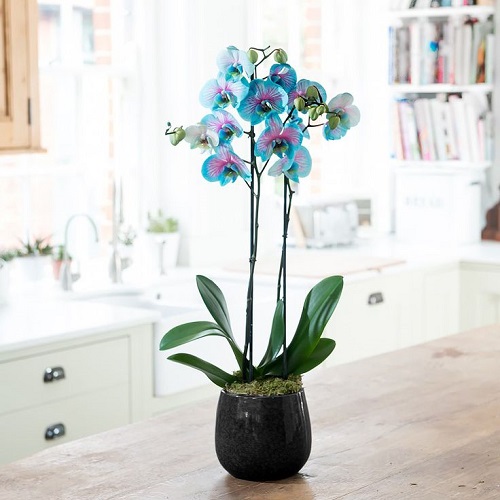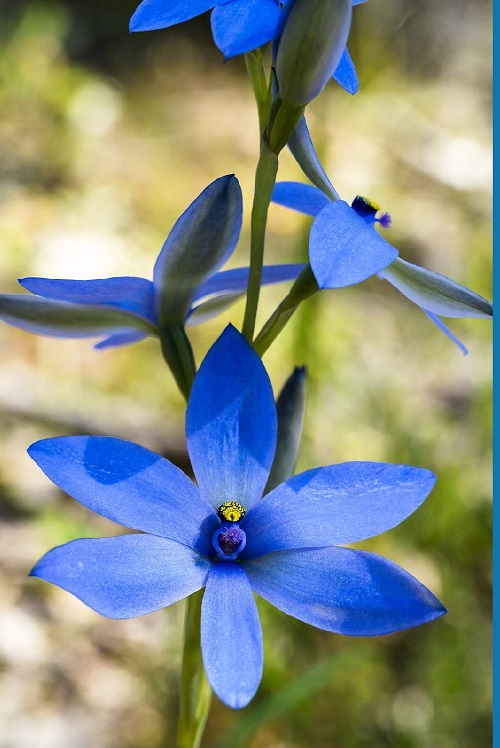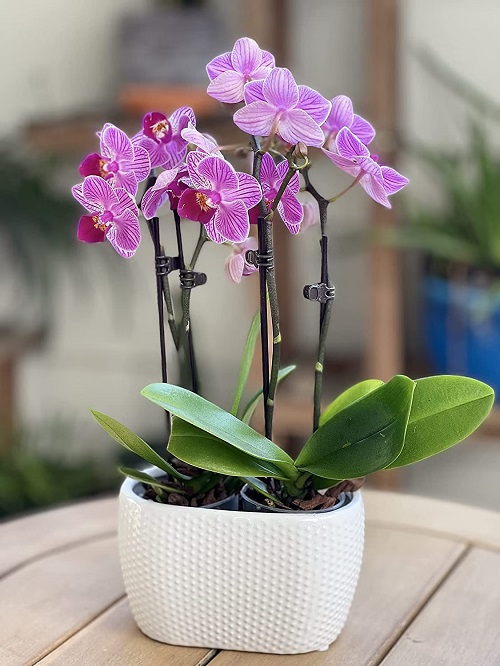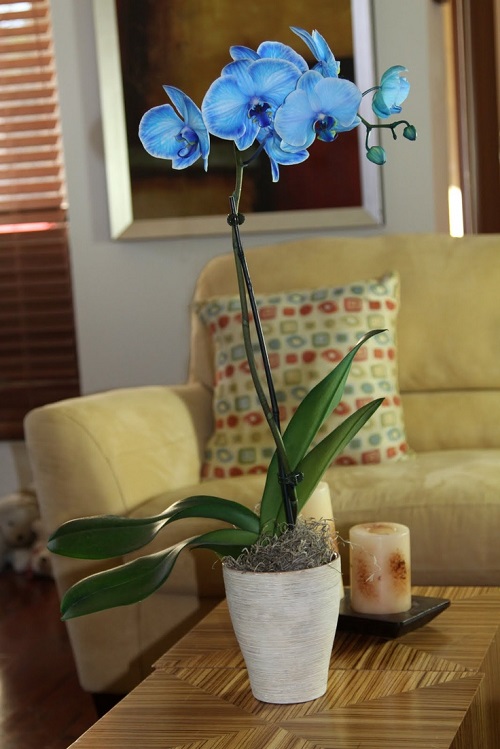Unravel the mystery of Blue Orchids—Are they real or a clever human invention? Learn in this informative article below!

Blue Orchids are a rare and captivating sight in the world of orchids. However, the mystery continues as not all the vibrant orchids you find around are real. Well, you read that right. The captivating flower that decks your neighbor’s coffee table may or may not be a real one. Let’s cut to the chase and learn about Blue Orchids in detail!
Look at some Stunning Yellow Orchids here
Are Blue Orchids Real?
Yes, Blue Orchids are real, but before you extract a conclusion, here’s something you need to know—while there are a few species of naturally occurring Blue Orchids, most of the specimens found in floral shops are not naturally blue.
Instead, they are white orchids, primarily of the phalaenopsis and dendrobium varieties, that have been artificially dyed to achieve their vibrant blue hue. This process involves injecting a patented dye solution into the spike after the flowers have opened, resulting in an electric blue tint.
Although these blue-dyed orchids are real in the sense that they are living plants, their color is not a product of their genetics. Naturally, blue orchids remain rare, elusive, and highly sought after by collectors and enthusiasts alike.
How Do Orchids Become Blue?
The blue-flowered phalaenopsis orchid, first introduced in 2011, was created by injecting patented water-based dye solutions into the xylem of the flower spike after the flowers had opened. The depth of color varies depending on when the dye is injected, with lighter hues resulting if the flower is still in the bud stage.
Note: Do remember that only those buds produce Blue Orchids that are injected with the bud. The vibrant hue fades back to white when the plant produces the next set of flowers.
Learn about the Best White Succulents here
Are Blue Orchids Toxic?
While there has been some debate surrounding the potential toxicity of artificially dyed blue orchids, primarily due to the fact—that the dyes used in the process of creating Blue Orchids are water-based and can vary in composition from one manufacturer to another.
Some growers utilize food-grade coloring; however, it is difficult to know the full list of ingredients used in each dye. As a result, the potential toxicity of these artificially colored orchids remains uncertain.
To be on the safe side and minimize the risk of accidental ingestion or exposure, consider placing the Blue Orchids out of reach of children or pets or opting for naturally colored orchid varieties instead.
Real Blue Orchids
1. Blue Vanda

Botanical Name: Vanda coerulea
Sporting true purple-blue flowers, this orchid is a rarity in the plant world. Discovered in 1837, it showcases a vivid color that adds a touch of exotic beauty to any collection.
2. Blue Lady Orchid

Botanical Name: Thelymitra crinita
This orchid variety features bright blue petals with contrasting black and yellow columns in the center. The vibrant blue hue is a visual delight and makes this orchid truly unique.
3. Acacallis Orchid

Botanical Name: Acacallis cyanea
This South American orchid has metallic blue blooms that become more vibrant in bright, indirect light. The flowers have a unique iridescent quality, making them stand out in any setting.
4. Purple Star Orchid

Botanical Name: Violacea coerulea ‘Purple Star’
Exhibiting a combination of blue and purple tones, this compact orchid variety is easy to grow and adds a touch of elegance to any space.
5. Bollea Orchid

Botanical Name: Bollea Coelestis
Native to the South American Andes, this orchid is difficult to cultivate. It rewards growers with its purple-blue flowers and a sweet, musky scent that is both intriguing and pleasing.
Find some Captivating Red Flowering Succulents here
Dyed Blue Orchids
6. Blue Mystique Orchid

Featuring a lively blue shade, this orchid variety is developed using a secret infusion formula. The dyed petals create an eye-catching display, perfect for adding a pop of color to any space.
7. Royal Blue Phal

Developed by the floriculture industry, this deep Blue Orchid is created using a special infusion process. The intense blue color makes it a favorite among plant enthusiasts.
8. Blue Dendrobium

Showcasing a series of pigmented and intense blue flowers, this orchid variety is a dazzling addition to any home. The vibrant blue hue flushed with purple and white tints brings an exotic touch to the plant collection.
9. Phalaenopsis Orchid

This popular dyed Blue Orchid is achieved by injecting dye into a white Phalaenopsis Orchid. The result is a vivid blue hue that stands out but reverts to white in subsequent blooms.
Look at some Stunning Blue Houseplants here
Quick Care Tips for Blue Orchids
- Lighting: Blue Orchids, like most orchids, require bright but indirect light. Place them near an east or west-facing window, or use a sheer curtain to filter the direct sunlight.
- Temperature & Humidity: Blue Orchids thrive in temperatures ranging from 60-75°F (15-24°C) during the day and 55-65°F (13-18°C) at night. Ensure that the temperature does not drop too low, as this can lead to bud drop or stunted growth. Maintain a humidity of 50-70%.
- Potting Medium: Prepare a well-draining substrate—combining equal parts of fir or monterey bark and perlite. You may also opt for an all-purpose orchid potting mix to minimize the hassle.
- Watering: Water your orchids thoroughly, allowing the water to drain from the pot and let it dry before watering again. Over-watering can lead to root rot, while under-watering can cause the plant to become dehydrated.
- Fertilizing: Fertilize the plant once a month with a balanced orchid fertilizer, diluted to half the recommended strength.
- Pruning: Remove spent flower spikes to encourage new growth and maintain the plant’s overall health.
- Monitoring: Keep an eye on your Blue Orchids for any signs of pests or diseases. Treat issues promptly with insecticidal soap or neem oil spray.
Troubleshooting Tips for Dyed Blue Orchids
- Fading Color: Do remember that the blue color in dyed orchids is temporary and will fade over time. As new flowers emerge, they will likely return to their natural color, usually white. To maintain the blue appearance, you can opt for a florist-approved dye, but remember that repeated dyeing can stress the plant.
- Stress Recovery: Dyed orchids undergo stress during the process. To help them recover, ensure they receive optimal care, such as consistent watering, adequate humidity, and appropriate lighting. Avoid repotting or pruning immediately after dyeing to minimize additional stress.
- Root Care: The dyeing process can impact the orchid’s roots, making them more sensitive. When watering, be extra cautious not to over-water, as this can lead to root rot. Monitor the roots regularly for any signs of damage or disease and address issues promptly.
- Nutrient Absorption: Dyed orchids may experience reduced nutrient absorption due to the dye. To help support their health, consider using a balanced fertilizer that promotes overall plant well-being. You can also try using a fertilizer with higher phosphorus content to encourage healthy root growth and flowering.






